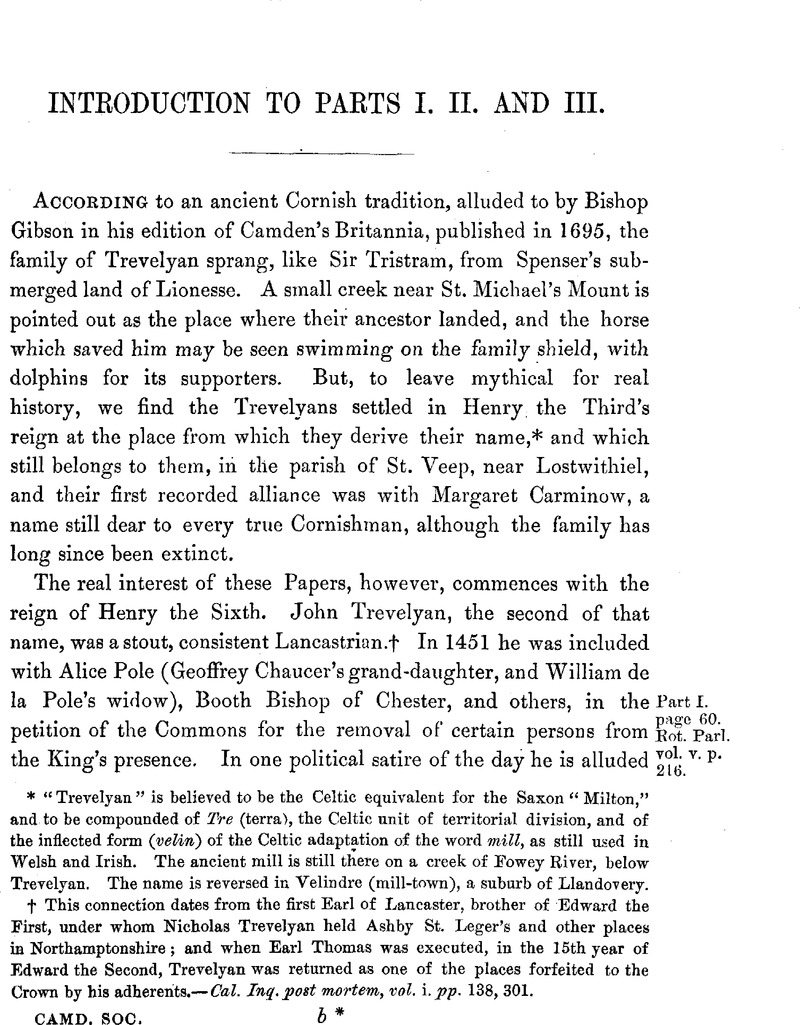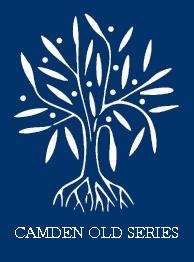No CrossRef data available.
Article contents
Introduction to Parts I. II. and III
Published online by Cambridge University Press: 24 December 2009
Abstract

- Type
- Introduction
- Information
- Copyright
- Copyright © Royal Historical Society 1872
References
page v note * “Trevelyan” is believed to be the Celtic equivalent for the Saxon “Milton,” and to be compounded of Tre (terra), the Celtic unit of territorial division, and of the inflected form (velin) of the Celtic adaptation of the word mill, as still used in Welsh and Irish. The ancient mill is still there on a creek of Fowey River, below Trevelyan. The name is reversed in Velindre (mill-town), a suburb of Llandovery.
page v note † This connection dates from the first Earl of Lancaster, brother of Edward the First, under whom Nicholas Trevelyan held Ashby St. Leger's and other places in Northamptonshire; and when Earl Thomas was executed, in the 15th year of Edward the Second, Trevelyan was returned as one of the places forfeited to the Crown by his adherents.— Cal. Ing. post mortem, vol. i.pp. 138, 301.
page vi note * On the death of Elizabeth's father, Thomas Whalesborough, her mother, Maud, paid a relief for four knight's fees to the sorely-tried Lady Margaret of Hungerford and Botreaux, who lost her son and grandson on the Lancastrian side, but re-established her family, after all, in the person of another grandson. I., p. 86.
page vii note * This was the Exeter branch of the general insurrection organised by Buckingham :—
“In Devonshire
Sir Edward Courtney, and the haughty prelate
Bishop of Exeter, his elder brother,
With many more confederates, are in arms.”
Skakespeare's Richard the Third,
page viii note * The authority for this appointment kis the Account of the Treasurer of the King's Household, 2 and 3 Henry VII. preserved among the public records.
page x note * There were the remains of a whole artillery of bows and arrows, but only three wheel-lock flint guns (“Stockes lockes, two of them with keys”). It appears from a memorandum dated in in 1545 (III. p. 16) that the best of the body armour was subsequently removed from Whalesborough.
page xiii note * See also the letter from the same person at page 61. “The Court never flourished as now. The King upon the disputation shewed himself admirable upon the queries, and for divinity put them down, both bishops and the rest. We shall have no [more] excommunications, and all spiteful bravery goes down, insomuch there is great hope of reformation.”
page xv note * viz., Londonderry, with Clogher and Eaphoe in commendam.
page xvi note * Nicholas Willoughby junior, who was educated at Trinity College at the expense of Lady Howth and Dean Culme, afterwards lived in comfort and prosperity in Fermanagh. See his brother-in-law John Mallock's letter at p. 292. For a characteristic example of the vicissitudes of the Irish life of that day, see another letter from John Mallock at p. 275.
page xviii note * Horned cattle.
page xxi note * “Little John my son “(p. 183), who appears to have been left under John Willoughby's care, afterwards adopted the profession of his father and elder brother. See his letter from Breda, announcing his capture on his passage to the Netherlands (p. 191), and another dated in March, 1643, boasting of his having taken a pair of colours from the Cavaliers at Marlborough (p. 233). Charles Steyning, the head of * this family at Holnicott, complains in 1648–9 of the severe burden caused by the quartering of the Parliamentary troops upon the rural districts (pp. 269–71).
page xxi note † For notices of this branch of the family see the Trevelyan pedigree, and Part II. of the Papers (pp. 112–118).
page xxiii note * This was addressed to the Earl of Pembroke the Lord Lieutenant of Cornwall.
page xxv note * John Treyelyan appears to hare ordered the armour in expectation of accompanying the Earl of Essex's unfortunate expedition to Ireland.
page xxv note * John Willoughby junior's relations with John Bartlett the carrier between Devonshire and Oxford (pp. 176–7) sa\our strongly of the feeling expressed hy Milton, in his verses on Old Dobson, the University carrier.
page xxvii note * See the satirical ballad, entitled “Sir John Suckling's Campaign,” in “Percy's Beliques.”
page xxvii note † The events described happened on the 1st May, and are noted in Pepys' “Diary “of the following day.
page xxviii note * This was the rumour of the day. Two months before, Pepys, alluding to the prevailing doubts about Lawson, says, “but all that is nothing.” He notices Lambert's escape from the Tower in his “Diary “of the 14th April, and afterwards his recapture and transfer to Scilly.
page xxix note * Windebank.
page xxix note † Williams.
CAMD. SOC. e
page xxx note * Littleton.
page xxxii note * Nobody who reads the letters at pages 260, 271, written to John Willoughby by clergymen to whom he had shewn kindness in those troubled times—”under so general a loss of kindness to our profession,”—can doubt which cause was nearest his heart.
page xxxii note † Clarendon says there were only about 120, but the loyal spirit of Cornwall soon swelled this small band into a formidable force, as may be seen from the apprehensions exhibited in this circular, as well as from the satisfaction expressed by John Mallack (page 230) at the arrival of the Earl of Stamford's troops, shortly after defeated at Stratton.
page xxxvi note * John Earl of Lincoln, son of this Duke of Suffolk, was selected by his uncle Richard to be his heir presumptive to the throne of England. After Henry the Seventh's accession he took refuge with his aunt the Duchess of Burgundy, and was killed at the battle of Stoke, where he commanded on behalf of Lambert Simnel. His brother Edmund, Earl of Suffolk, was beheaded by Henry the Eighth.
page xxxvii note * Kinswoman. The precise relationship was brother-in-law's mother. Her tomb in the parish church of Ewelnie, in Oxfordshire, is, perhaps, one of the most splendid, and in the best preservation, of any belonging to that remote period, in the kingdom. It has no less than fifty alabaster figures of angels about it.
CAMD. SOC. f
page xxxviii note * Cousin is here again used in the general sense of relation, for George Trevelyan was Mr. Luttrell's nephew.
page xl note * In some parts of Kent and Sussex “the wheeled carriages were generally pulled by oxen.” Macaulay's History, vol. i. p. 375.
page xlii note * Sir George Trevelyan married Mary, daughter and heiress of John Willoughby, Junr., of Peyhembury and Seaton. Margaret Trevelyan's story is embellished with literary ability in “Thornbury's Tour in the West of England.” Many years before, the same story, as told by our grandfather to Dr. Duncan of New College, Oxford, was made use of by him for a child's book, in which was a picture of Mrs. Trevelyan in her coach drawn by oxen. Frequent allusion has been made to the story in periodical works.
page xliv note * George Trevelyan's Cornish estates, for instance, were erroneously supposed by the Committee of that County not to have been included in his composition, upon which elaborate proceedings followed, supported by detailed depositions, resulting, first, in an order for the restitution of the estates and for the repayment of the rents which had been received, and afterwards, in some subordinate officials, who had kept back a portion of these rents, being forced to disgorge.
page xlv note * This was the inheritance of the Cockworthies, who were descended, through the Champernowns and Valetorts, from Edmund Earl of Cornwall, son of Eichard King of the Romans, second son of King John. This family ended in three co-heiresses, who married respectively Fortescue. Monck (ancestor of the Duke of Albemarle), and Trevelyan.—Carew's Survey of Cornwall, pp. 243, 2H. Avice Cockworthy insisted upon Yarnscombe and Old Knoll (a Raleigh estate) being assigned to Thomas, her youngest son, which led to a prolonged litigation adverted to in Chief-Justice Fitzjames's letter to Secretary Cromwell, Fart II. p. 55. The descent of the Yarnscombe branch is shown in the Trevelyan pedigree.
CAMD. SOC. g
page xlvi note * Richard Trevillian of Midelney, Somerset, one of the Somersetshire Committee, whose signature is attached to some of the documents in the Appendix, was born in 1612, and died in 1679. His grandson, John, was High-sheriff of Somerset in 1715, and married one of the co-heiresses of Jenyns of Burton Pynsent, but dying without issue, he was succeeded by his sister Millicent, who married William, grandson of” Edward Ceely of Charlton, in the parish of Creech St. Michael, whose signature also occurs as another member-of the Committee. In 1774 their descendant, Maurice Ceely, obtained the Royal licence to take the surname, and to bear the arms of Trevillian, in addition to his own.


